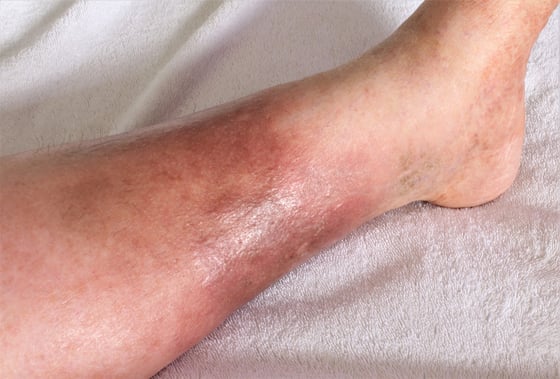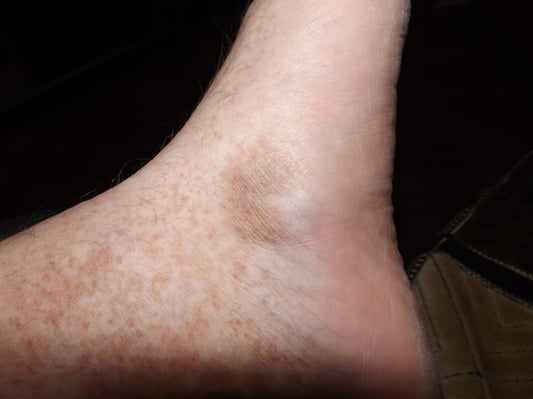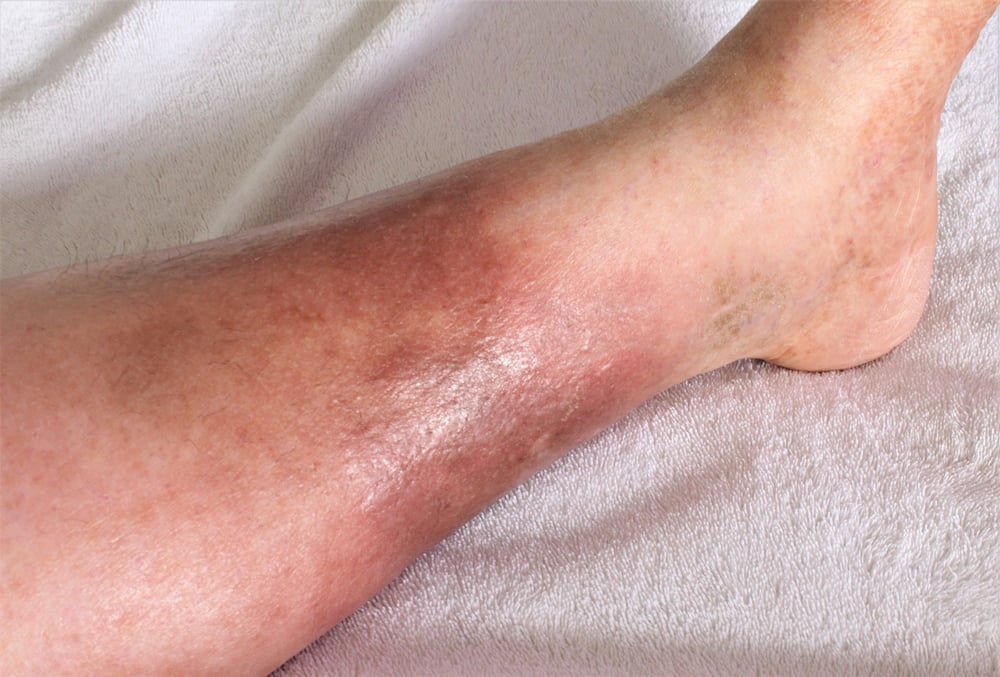Brown Skin Patches on Legs | Hemosiderin Staining Guide

Have you ever noticed brown, splotchy discoloration on your lower legs or around your ankles and wondered what it could be? You are not alone. Seeing these changes in your skin can be concerning, and many people want to understand what causes them and, more importantly, if they will ever go away. While a final diagnosis is difficult without seeing them in person, these brown stains often point to a few common causes, one of the most frequent being an underlying vein condition.
Key Takeaways
- Brown discoloration on the lower legs and ankles, known as hemosiderin staining, is often caused by an underlying vein condition called venous insufficiency.
- The staining occurs when red blood cells leak from high-pressure veins and break down, leaving iron deposits (hemosiderin) in the skin, similar to how a tattoo works.
- When related to a vein condition, these splotches typically appear around the inner ankle and may be accompanied by swelling, leg pain, fatigue, or restless legs.
- While vein treatment can stop the progression of the staining and may lighten it, it often does not make the discoloration disappear completely.
- Seeking an evaluation from a primary care provider or vein specialist sooner rather than later is crucial to prevent the staining from worsening over time.
What Causes Brown Splotches on Your Legs and Ankles?
That dark, freckle-like discoloration you see on your lower leg, ankle, or foot is often caused by the breakdown of hemoglobin in the blood. Our red blood cells contain iron, which is essential for carrying oxygen. When these red blood cells leak out of tiny blood vessels and break down under the skin, the iron component is left behind. This creates a brownish pigment called hemosiderin, which stains the surrounding skin cells.
While there are several potential causes for this type of skin discoloration, it’s important to understand the possibilities.
Sunspots or Age Spots:
Sometimes, brown spots are simply what they appear to be - harmless spots on the surface of the skin caused by years of sun exposure and the natural aging process.Schamberg's Disease:
This is a less common condition that causes brown or reddish-brown splotches, often described as looking like cayenne pepper, to appear on the calves and feet. The exact cause is unknown, so a consultation with a dermatologist is important for an accurate diagnosis.
Hemosiderin Staining from a Vein Condition:
This is one of the most common causes I see in my practice. When the discoloration is related to a vein issue, it follows a very predictable pattern and is accompanied by other tell-tale symptoms.
The Link Between Skin Staining and Vein Conditions
When brown splotches are caused by a vein condition, it's a direct result of something called venous insufficiency, or vein reflux. This happens when the tiny, one-way valves inside your leg veins become weak or damaged. These valves are supposed to help push blood back up toward your heart against gravity. When they fail, blood flows backward and pools in your lower legs.
This pooling of blood dramatically increases the pressure inside the veins. The tiny blood vessels (capillaries) can't handle this high pressure, and they begin to leak. Red blood cells seep out into the surrounding tissue. Your body’s natural cleanup crew comes in to break down these escaped cells, but the iron-rich hemoglobin gets left behind. The skin cells absorb this leftover hemoglobin, and just like tattoo ink, it permanently stains the skin a reddish-brown color. This is what we call hemosiderin staining.

How to Tell if Your Skin Stains Are Vein-Related
If your skin discoloration is from a vein condition, there are a few characteristics to look for.
1. Check the Location of the Stain.
Vein-related staining almost always appears in a specific area known as the "gaiter zone"—the lower part of the leg, from the mid-calf down to the ankle. It most commonly starts around the inner ankle. This is the area where the pressure from venous insufficiency is the greatest.
2. Look at the Texture of the Skin.
Often, the skin beneath the stain will feel different. It might be thickened, hard, or leathery to the touch. This is due to the chronic inflammation caused by the pooling blood. This condition is known as lipodermatosclerosis and is a clear sign of an advanced vein problem.
3. Are There Any Other Symptoms?
Skin staining is rarely the only symptom. People with vein-related discoloration also typically experience one or more of the following:
- Leg swelling, especially at the end of the day.
- A feeling of heaviness, aching, or fatigue in the legs.
- Restless or "jumpy" legs at night.
- Painful leg cramps, particularly during sleep.
- Itching, burning, or stinging sensations, often around the ankles or feet.
These symptoms tend to get progressively worse throughout the day and feel much better in the morning after your legs have been elevated all night. Many primary care providers may not immediately connect brown splotches around the ankle to a vein condition, but for a vein specialist, it's a classic sign that we can easily diagnose.
Will the Brown Splotches on My Legs and Ankles Go Away?
This is the most common question I hear from patients with hemosiderin staining, and it’s an important one. The honest answer is that vein treatments can help, but they typically don't make the discoloration go away completely.
Once the iron from the hemoglobin has stained the skin cells, it is very difficult for the body to remove it. However, this shouldn't be discouraging. The primary goal of vein treatment is to stop the underlying cause—the venous reflux. By closing off the faulty veins, we stop the leaking and prevent any further staining from occurring. We are essentially stopping the progression of the condition.
I have seen many patients whose brown splotches have lightened significantly after treatment. They are often thrilled with the improvement in how their legs look and, more importantly, how they feel. Without treatment, the staining will only worsen over time, and the skin can become more fragile, leading to a higher risk of non-healing sores or ulcers. That's why seeking an evaluation sooner rather than later is always the best course of action.
Frequently Asked Questions (FAQs)
1. Is hemosiderin staining dangerous?
The staining itself is not dangerous, but it is a clear sign of an underlying medical problem—chronic venous insufficiency. If left untreated, this condition can progress and lead to more serious issues like skin breakdown, chronic inflammation, and venous ulcers (non-healing wounds).
2. Can creams or lotions remove the brown spots?
Unfortunately, no. Because the stain is caused by iron deposits deep within the skin tissue (like a tattoo), topical creams and lotions cannot remove it. They may help moisturize the skin, but they won't change the color.
3. How do you diagnose if the staining is from a vein condition?
A vein specialist can often make a diagnosis based on the appearance and location of the stains, along with a physical exam. The gold standard for confirming the diagnosis is a simple, painless Duplex ultrasound, which allows us to see the blood flow in your veins and identify any faulty valves.
4. What does treatment for the underlying vein condition involve?
Modern vein treatments are minimally invasive and are performed right in the office. Procedures like endovenous laser therapy or sclerotherapy are used to close the damaged veins. This reroutes blood flow to healthier veins, reduces the pressure in your lower legs, and stops the leaking that causes the staining.
5. If the stains don't go away, why should I get treatment?
The most important reason to get treatment is to stop the disease from progressing. Treatment will prevent the staining from getting darker or spreading. It will also alleviate other uncomfortable symptoms like pain, swelling, and leg cramps, and it will significantly reduce your risk of developing more serious complications in the future.




